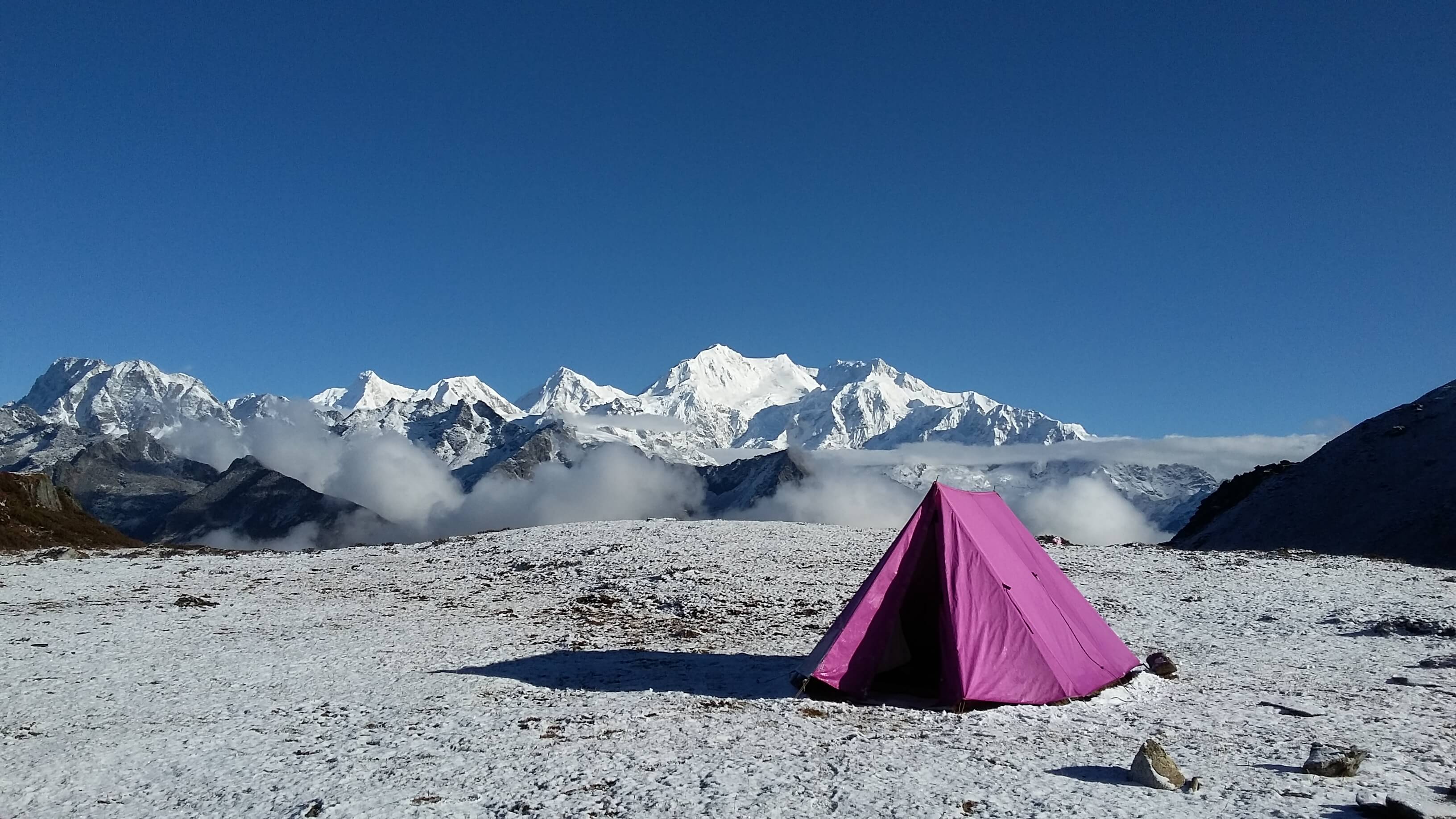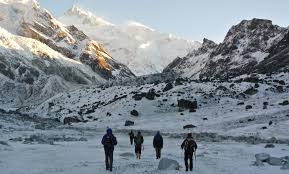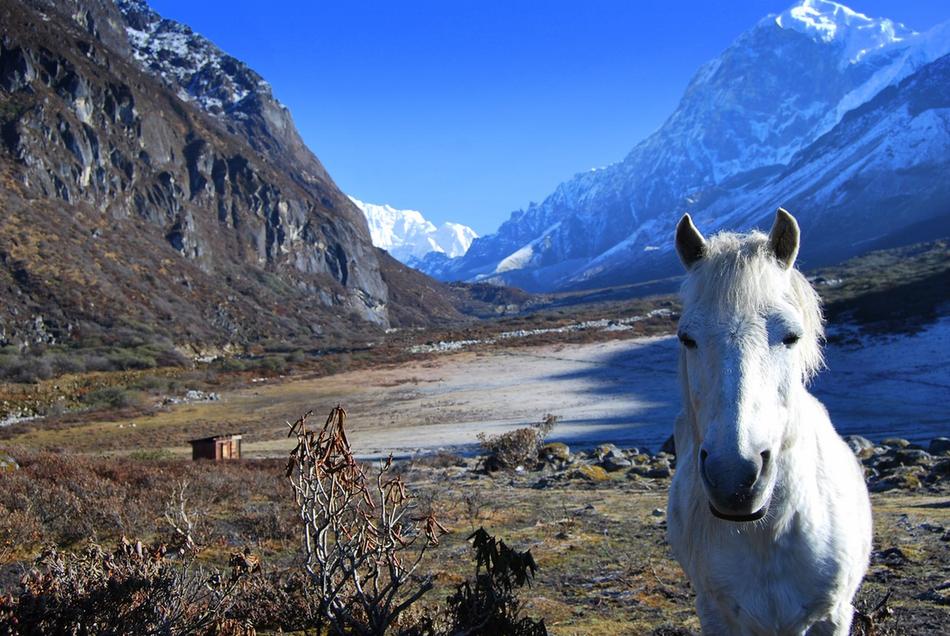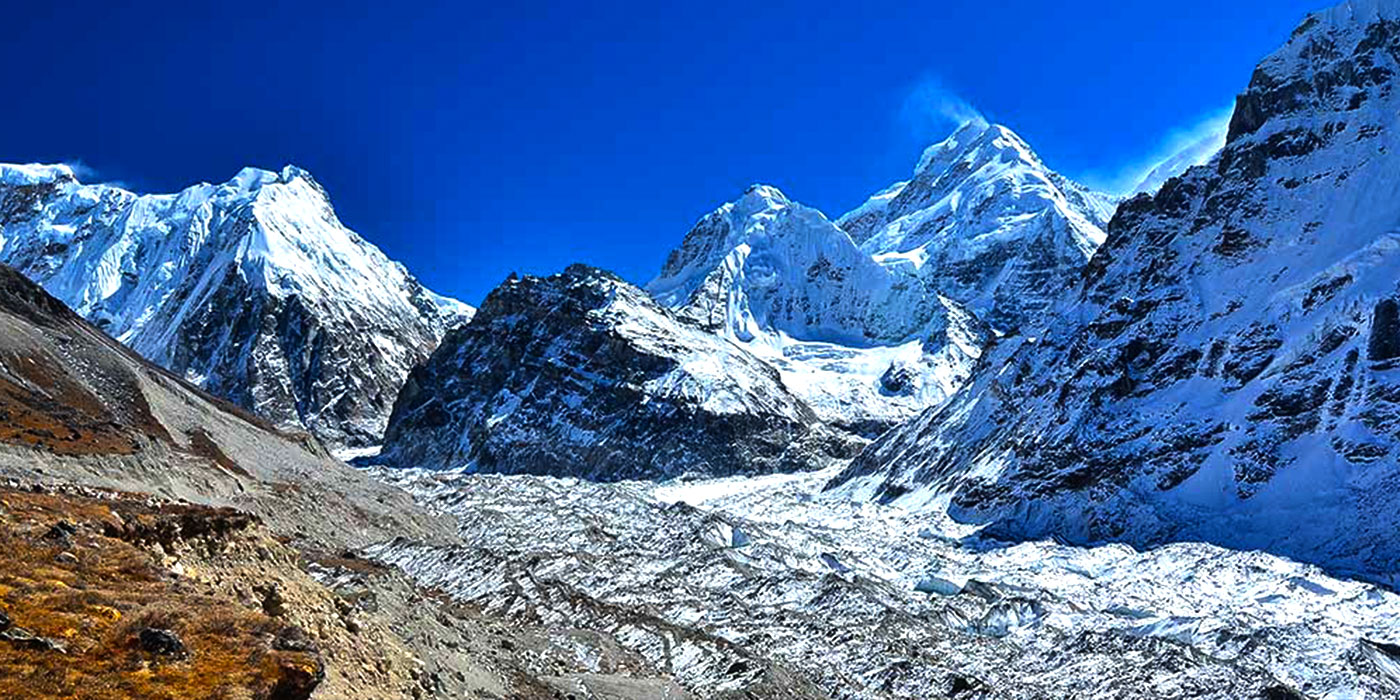Trip Overview
Yambong singalila trek is one of the less explored trekking routes where the view embraces five summits rising above 7000m, amongst them are Mt. Everest, Mt. Makalu, and Mt. Lhotse of Nepal and Mt. Kanchendzonga and Mt. Pandim of Sikkim.
During this trek, one walks on the narrow paths adjacent to the Indo-Nepal border, sometimes at the edge of the jungle, sometimes through rhododendron forests, and sometimes along the top of the ridges. The visit to some of the beautiful high-altitude lakes in this trek will give a blended touch of both nature and culture which make the journey a rare venture.
Yambong singalila range is one of the few habitats which provides shelter to many endangered wild animals. In this range, one would see animals like Red Panda, Himalayan Tahr, Blue Ship, Himalayan Black Bear, and spectacular pheasants like Satyr Trapogan, Himalayan Monal, and Blood Pheasant.
Yambong Singalila Trek can be started from both Yuksam and Nambu Village and ends up on the other side.
Itinerary
- +
Day 1
Nambu to Sangkhola to Chongri – (2050m/7 km/4-5 hrs) (camping) - B/L/D
Today after the bit early breakfast and finishing up the trekking checkpoint formalities we will begin our first day of the trek through the semi-tropical forest, home to a variety of flora and fauna. The trails go all the way down to the river at first for an hour or more and then a gradual upwards trek for an hour or more will take us to SHANGKHOLA, a small village settlement. From here onwards the trail goes up at 45 to 70 degrees uphill till our campsites CHONGRI, again a small but bit bigger and last village settlements. The trail we will be following till our campsite from Nambu is a regular village hiking/walking trails which are used by the local peoples as well in there day to day life and the trails normally go through the scattered village household all the time. Along the trails, one will come across the beautiful bamboo and hanging bridges which are antique in themselves and are picture-perfect for the lovers of photography. On today’s trek, one will have a rare opportunity to see or experience very close-up looks of the typical village lifestyle and can interact with those ever smiling and welcoming mountain peoples. Lunch at the campsite.
- +
Day 2
Chongri to Naya Patal - (3000m/6 km/4-5 hrs) (camping) - B/L/D
After breakfast, we continue our uphill journey through the temperate forest leaving back the beautiful last mountain village settlements to our campsite NAYA PATEL, which is a large clearing in the middle of the scattered temperate forest. Here one can have a rare opportunity or need a bit of lady luck for spotting a rarest of the rare animal – RED PANDA, which has, are, and have been spotted most often in this area. Today our trekking trail often passes through the middle of the scattered temperate forest and one might see a few yak herders and shepherds along the side of the trails, however, it is quite rare as those people usually stay away from the trekkers and other unknown peoples. Due to the government's ultimatum to stop grazing in the Himalayan region of Sikkim those people are facing difficulties and usually hiding away from other peoples and officials. Lunch at campsite.
- +
Day 3
Naya Patal to Lower Yambong – (3300m/7 km/5-6 hrs) (camping) - B/L/D
Today we will begin our trek with the usual schedule and timing. We will have to continue our trek uphill through the temperate and alpine forest. The trails go through the temperate forest which habitat numerous wild flora and fauna and at a later point close to the camp gives way to Alpine vegetation. Some of the medicinal plants you can come across in the temperate forest are Jatamasai and the Rhubarb. The Monal Pheasant, Marmots, Red Panda, Blue Sheep, Shapi, and the Tibetan wild-ass are some of the animals that habitats in these areas and it's surrounding. On this day one can see the vegetation gradually transforming from temperate to alpine. Chestnuts groves give way to Pine trees and the Azaleas replace the views of dwarfs bamboo and ferns.
- +
Day 4
Lower Yambong to Upper Yambong – (3735m/6 km/4-5 hrs) (camping) - B/L/D
Today the trek will again begin with the gradual uphill walk and at a later part of the trek, the trail will decent down. Today the trail will be up and down most of the time throughout the trek. Today’s trail is mostly dominated by the rhododendron and the primulas which bloom beautifully during May – June. From today onwards we are surrounded by the Alpine vegetation and will continue for few more days till we descend to Yuksam from Dzongri. Lunch at campsites.
- +
Day 5
Upper Yambong to Gomathang – (3500m/5 km/4-5 hrs) (camping) - B/L/D
Today we will begin our day with a pleasant mood as today we will have our first encounter with the mighty Himalayas of Sikkim, Mt. Kanchendzonga, Mt. Pandim, Mt. Kabur North and South, Mt. Sinolchu, Mt. Tenchenkhang, and a few more and if the weather is with us we will see the Mountains of Nepal side too. Mt. Everest, Mt. Lhotse, and Mt. Makalu are the mountains of the Nepal side which is visible from DAFEY BHIR. The spectacular view of all these Himalayas is possible from the DAFEY BHIR viewpoint which is approximately 800m from the DAFEY BHIR. Lunch at the campsite.
- +
Day 6
Gomathang to Pangding – (4210m/5 km/4-5 hrs)(camping) - B/L/D
Today we will wake up early in the morning at around 3 to 4 am to visit the viewpoint of DAPHEY BHIR, which is the most important viewpoint along the way after the DZONGRI viewpoint. The trekking staff will carry some biscuits, boiled eggs, boiled potato, and chocolates for the viewpoint. From here one can have a spectacular view of the mountain of both Sikkim and Nepal. Some of the mountains we can see from here are Mt. Everest, the highest mountain in the world, and Mt. Kanchendzonga, the third-highest in the world with a few hundred meterless. Breakfast on the way back from the viewpoint and start the day trek which is relatively easy with gradual descent and ascent along the way. Today the trail will cross three valleys of small rivers TIKIP CHU, YANGSAP CHU, and BOKTOK CHU, and two passes of KOKLING (4400m) and YANGSAP (3950m), which may be snowbound between December to April. En route one can see the KHANGLA PASS (5004m) amidst a black rocky range of mountains and also occasional glimpses of DAFEY BHIR, the steep rocky climb coming up on the following day. From Pangding one can have a great close-up view of Mt. Kabru, Mt. Kokthang, Mt. Pandim, and Mt. Rathong.
- +
Day 7
Pangding to Dzongri – (4020m/9 km/6-7 hrs)(camping) - B/L/D
Today our route joins the regular trail up to Goecha La. A steady climb through ancient fir forest, juniper, and rhododendrons gradually open out to the summer pasture of Dzongri. Another high camp, but we should be well acclimatized by now probably in contrast to some of the trekkers we meet who could be on day 3 of their Dzongri Trek at 4000 m/4020m. “ Headache Zone”. Dzongri is regarded as the most important place as far as the trekking to Goechala and other trekking destinations in this part of Sikkim is concerned due to its spectacular viewpoint and scenic beauty. Here one can have a great one-day rest for acclimatization and hiking around its surrounding is a treat in itself. Lunch at campsite.
- +
Day 8
Dzongri to Thangshing – (3860m/6 km/4-5 hrs) - B/L/D (camping)
Today we have to wake up early in the morning at around 4 am and after some tea and biscuits head for DZONGRILA VIEWPOINT to see the spectacular and panoramic view of mountain Kanchenjunga and its neighboring peaks with sunlight. The best view possible from goshala or any other trek in this region is from this viewpoint After breakfast, the day’s walk starts with a short climb to a ridge and a walk for an hour or more through the beautiful alpine terrain and later followed by a rapid steep descend of 100m to Kockchurung and Prek river. Continue crossing some boulders and climb gently to the campsite of Thangsing for our lunch with a view of Mt. Pandim and Mt. Kanchenjunga.
- +
Day 9
Thangshing to Goechala to Kockchurung – (4940m/3700m/14-16 km/8 -10 hrs) (camping/huts) - B/L/D
A very early morning wake up at around 2 /2.30 am for visiting the Goechala viewpoint with sunlight light. Early morning bed tea and biscuits will be served. The trekking staff will carry snacks like biscuits, boiled eggs, boiled potato, and chocolates for the viewpoint. Early morning excursion to Goechala (pass), one walk along the moraine path by the side of Samiti lake to view the east face of Mt. Kanchendzonga bathed in the rays of the early sun. later one has to cross the ½ km sandy plain known as Zemathang, footprints of Bluesheeps and other animals are a common sighting. After 1 ½ to 2 hours walk, one arrives at the 1st viewpoint of Goechala, and walking further 2 hours will take to 2nd viewpoint to enjoy the close-up views of Mt. Kanchendzonga 8534m. Return to camp for late lunch and later walk to kockchorung campsite.
- +
Day 10
Kockchurung to Tshoka – (3050m/10km/5-6hrs) (camping/huts) - B/L/D
After breakfast, trek back the same trail till Kockchurung which has already been used before for way up. From here instead of going back through Dzongri one has to follow the alternative trails which head directly to Phedang campsite which is a regular lunch point both on the way up and down. The trail from kockchorung to Phedang is spectacular and scenic as the trail goes through the thick Rhododendron forest. The zig-zagging trail stretch for around 3 to 4 hours till Phedang. Further downhill walks for around 2 hours, one reaches a Refugee settlement of Tshoka, small village settlements of refugees who have been residing here for the last 30 to 35 years. Very recently the government of Sikkim has issued an ultimatum to vacant the areas for which they will been given land in Yuksam. This step has been taken by the government to preserve the high altitude forest areas from deforestation, overgrazing by animals and to maintain the Ecosystem.
- +
Day 11
Tshoka to Yuksam – (1785m/13km/6-7 hrs) (hotel stay)
After breakfast trek downhill for an hour or less to Bakhim, a camping area for the Himalayan Mountaineering Institute. Further downhill trek for an hour or a bit more, one reaches Prek Chu, a river with a large hanging bridge. A further walk for an hour or so one reaches the campsite of Sachen, which is normally used by the trekkers who are physically not ready for the first day-long trek to Tshoka on their way up from Yuksam. Lunch will be served either at Sachen or Tsushey, depending upon your guide and cook’s choice. A walk for around 3 hours, one reaches Yuksam, the first capital of Sikkim. Here one will come across the motor-able road. Warm water and a good shower will greet you in the hotel.
Trip Highlights
1) Yuksam - The first capital of Sikkim and a base camp of famous Goechala Kanchendzonga Trek and several Mountain Expeditions. The Oldest monastery of Sikkim, Dubdi Monastery is located at Yuksam. The Famous Coronation Throne where the first king of Sikkim was crowned by the three religious monks is in Yuksam.
2) Tshoka - A small Refuge settlement at the height of 3000m. A first-day camping point of the trek. From Tshoka one can see a glimpse of towering snow-capped mountain peaks - Mt. Pandim and few others.
3) Dzongri Viewpoint - The most beautiful and ideal viewpoint of high-altitude treks in Sikkim. One can witness a 360-degree view of the Pristine and Panoramic 16 snow-capped mountain peaks and hills. Located at the height of 4250m Dzongri Viewpoint offers sublime and capitative scenery of the entire Himalayan range...
4) Goechala Viewpoint - The closest point to Mt. Kanchendzonga - The guardian deity of Sikkim! The goechala viewpoint provides a sublime and closest view of Mt. Kanchendzonga and Mt. Pandim. One can have the closest look at Thalung Glacier too at the bottom of Mt. Kanchendzonga.
5) Samiti lake - One of the most pristine and holy high-altitude lakes in Sikkim. It lies exactly Infront of Mt. Kanchendzonga and is a treat to witness on a clear sunny day.
6) Laxmi Pokhari (Lake) in Dzongri - A pristine high-altitude lake situated 3 hours walk from the Dzongri Campsite
7) Dafey Bhir - A spectacular viewpoint from where you can see Mt. Everest, Mt. Lhotse, Mt. Makalu of Nepal, and Mt. Kanchendzonga, Mt Pandim, and other peaks of Sikkim.
8) Yambong – A beautiful valley mainly roamed around by the Yak and sheepherders
9) Gomathang – A beautiful alpine valley with mesmerizing landscape
10) Pangding – A beautiful campsite at the bottom of a big hill adjoining Dzongri
Health and Fitness
You have to be Relatively Fit and Healthy to undertake the Yambong - Singalila trek. Trekking for 6 to 8 hours a day is one of the most important requirements for this high-altitude trek. Apart from good health condition basic mental preparation is also very important to undertake this Trek.
People suffering from Acute Heart and Lung diseases, Asthma, and High blood pressure are not recommended to take up this trek.
To complete this high-altitude trek regular exercises like running, skipping, aerobics, Zumba, and long-distance uphill trekking (4 to 5 times a week) are highly recommended. One should start making basic physical preparation at least a month before a trek. These exercises help you during the Trek.
The packing of right and comfortable clothing also makes a difference in the completion of Trek, so it is necessary to be disciplined while packing your clothing for the trip. You can contact us for help with clothing choice and packing!
During the Trek, we provide a basic medicine Kit which includes Medicine for High Altitude sickness, Headache, Diarrhoea, Vomiting, Common Cold, etc. All of our medicine is scientific medicine purchased in India, however, we advised you to bring your small medicinal kit for the trip if possible.
Trekking/Tour Tips
1. A common tendency among young blood and beginners is to show enthusiasm by walking fast with excitement. Even the experienced sometimes try to show off by walking fast, this is soon exhausting and not recommended. Walk slow - warm up gradually and continue at a slow comfortable pace before pushing yourself a little more.
2. Develop a personal rhythm. Maintain your steps to synchronized with breathing. This will help minimize getting out of breath.
3. Walking in Himalayan trails with loose soil and rocks is tricky. So, avoid stepping on loose soil and rocks and place the foot flat and firm with a better grip. Always follow the rule ‘heel first’ while walking in the Himalaya trail.
4. Walking in a zigzags manner while ascending on a very steep slope is advisable. While descending walking zigzag is a good technique to avoid excessive pressure on knees and avoid knee pain and blisters.
5. Avoid stepping on loose stones and soil to avoid an accident.
6. Avoid overtaking fellow travelers on a narrow trail. Only Overtake at comfortable wide space if necessary.
7. While ascending and descending a slope or over loose stones, leave sufficient space between the next person so that any stone rolling down does not hit trekkers below.
8. Do not run down a slope. Bend knees a little while descending. Dig heels into soft snow or soft ground.
9. Our Himalayan condition is mostly wet so avoid wet grass, wet roots, and the muddy zone which can be very slippery. Be careful while walking on them.
10. Shortcuts on a foot trail should be avoided.
11. Always put-on warm clothing while taking a rest. This will help avoid getting cold, cough and high-altitude sickness
12. Respect the sentiments and traditions of the local hill people.
13. Always carry enough water in your water bottle as water is essential in avoiding altitude sickness.
14. Wear comfortable and right set of trekking boots, pants and jackets. Avoid wearing new trekking boots directly for the Trek. Get used to it by wearing before the trek. Carry all necessary clothing’s.
Halts and Rests:
1. While taking a rest, lie against a tree trunk, a big stone, or on flat ground. Place your legs on your bags or any other higher ground. This helps regulate blood circulation.
2. Stop at any comfortable point after the first start to readjust your rucksack, jackets, or to tie a shoelace for better comfort and adjustment.
3. Do not make frequent or prolonged halts. Too many small stops destroy the walking rhythm. Frequent rests are not helpful. You should follow your own rhythmic walking pace and technique to avoid unnecessary tiredness. A stop should be made only at natural stopping points, like on the top of a ridge, or before an ascent, or at a scenic viewpoint.
4. Stop and place yourself on the safer (Mountain) side to give way for the pack animals to pass through. Avoid bags carried by the animals that can push you. Be aware of the yak's horn too.
SERVICES INCLUDED:
1) HIGH ALTITUDE TREKKING PERMITS/PERMISSION
2) LOCAL ENGLISH SPEAKING GUIDE
3) EXPERIENCED LOCAL COOK
4) LOCAL PORTERS
5) PACK ANIMALS
6) 2 MEN TENTS / HUTS
7) KITCHEN & DINING TENTS
8) SLEEPING BAGS
9) MATTRESSES
10) HOT WATER BAGS
11) NATIONAL PARK FEES AND PERMISSION
12) TOURISM FEES AND PERMISSION
13) ENVIRONMENTAL FEES
14) ALL MEALS AND DRINKS THROUGHOUT THE TREK
15) TABLE & CHAIR
16) BASIC MEDICINAL KITS
SERVICES EXCLUDED:
1) INTERNATIONAL AND DOMESTIC FLIGHT TICKETS
2) TRANSPORTATION TO / FRO STARTING & ENDING LOCATION
3) INSURANCE OF ANY NATURE
4) ALCOHOL AND BEVERAGES
5) TIPS AND GIFTS
6) PERSONAL SHOPPING COST
7) ANYTHING NOT INCLUDED IN INCLUDED LIST
FAQ (Frequently Asked Questions)
HOW TO REACH YUKSAM?
The closest Airport to Nambu and Yuksam, Sikkim is PAKYONG AIRPORT & BAGDOGRA AIRPORT. You have to fly either to Bagdogra Airport or Pakyong Airport. From there you can drive to Yuksam with a private reserve vehicle.
Pakyong Airport is around 6 to 7 hours’ drive and Bagdogra Airport is around 7 to 8 hours’ drive from both Nambu and Yuksam.
WHAT GEARS AND CLOTHING TO CARRY FOR YAMBONG SINGALILA TREK?
No matter what season you are planning for the mountains are always going to be cold, rough, and tough so it is absolutely necessary to pack yourself with adequate and proper clothing. Here is the standard kit checklist for the Trek.
Proper packing of the trekking gears is absolutely necessary with eyes on the weight limit. It is important to have a good brand of clothing.
Basic Gears:
Back Pack & rain cover or Duffel bag (50 to 70 ltr)
Day Pack & rain cover (20 to 30 ltr)
Walking stick (1 pair or at least one)
Water Bottle (2 bottles of 2 ltr each)
Thermos flask (1 nos)
Head Light (1 Nos with 4 pairs of batteries)
Gaiters (1 pair)
Upper and Lower Clothings:
T - Shirt (2 to 3 full sleeves). Mostly noncotton
Fleece T-shirt (1 nos)
Thermal Inner-wears or base layers (1 nos or 1 pair) such as long jones
Fleece Jacket (1 nos)
Down, Feather, or Holofil Jackets (1 nos)
Wind and Waterproof jackets & pants (1 pair)
Trekking Pants (1 pair). Comfortable and durable
Short Trekking Pants (1 nos or 1 pair)
Poncho (1 nos)
Headgears:
Woolen cap (1 nos)
Sun cap (1 nos)
Balaclava or scarf (1 nos)
Sunglasses (1 nos) U/V protected and dark
Hand gears:
Waterproof gloves (1 nos)
Woolen gloves (1 nos)
Feet gears:
Waterproof Trekking boots (1 nos) preferably ankle high Goretex, North face, Colombia or Quechua
Snickers or running shoes (1 nos) preferably from any reputed brand
Gaiters (1 nos)
Sandals or flippers (1 nos)
Cotton socks (4 pairs)
Woolen socks (2 pairs)
Personal utilities:
Sunscreen cream
Moisturizers
Hand sanitizers
Toilet papers and wipes
Anti-bacterial powders
Lip balm
Toothbrush and toothpaste
Proper packing of the trekking gears is absolutely necessary with eyes on the weight limit. It is important to have a good brand of clothing.
CAN I EXIT YUKSAM ON THE LAST DAY OF THE TREK DIRECTLY?
Yes, you can if you are looking to reach any other location near to Yuksam OR if it is too urgent and necessary. Driving to Airport and Railway directly after the trek is not recommended.
We will advise not to plan to leave Yuksam directly after the last day of Trek as it will be too tiring and hectic. Driving at night on the Himalayan road is not comfortable and enjoyable.
The earliest you will reach Yuksam on the last day of the trek is around 1 pm so long hours drive thereafter is not possible.
CAN I LEAVE EXTRA BAGS AT NAMBU / YUKSAM AND COLLECT THEM ON THE LAST DAY OF THE TREK?
Yes, you can leave a bag of clothes with our office staff before the start of the trek at Nambu and collect it after the trek. In fact, we will advise you to leave one set of clothing for the last day as normally pack animals arrive late on the last day of the trek.
You can even keep valuables and cash at our office safely and collect them after the trek.
WHAT DOCUMENTS NEED TO BE CARRIED?
It is mandatory for Indian trekkers to carry identification documents such as VOTER ID CARRD, DRIVING LICENSE, AADHAR CARD, INDIAN PASSPORT. Original documents need to be carried along with 4 pcs PASSPORT SIZE photograph.
Foreigners need to carry INDIAN VISA, PASSPORT & SIKKIM INNER LINE PERMIT along with 4 pcs PASSPORT SIZE photographs.
A medical fitness certificate is also mandatory however this can also be arranged at Yuksam in case you are not able to bring it.
IS THERE CONNECTIVITY DURING THE TREK?
There is no phone connectivity during the Yambong Singalila trek. Nambu, Chongri, and Yuksam is the last village where you can get a phone and internet connection.
At certain specific locations between Chongri and Naya Patal, Dzongri, Phedang, and Tshoka, you can get Vodafone, Airtel, and Jio networks. Network largely depends on weather conditions of the given period.
There is no electricity throughout the Yambong Singalila trek.
HOW IS THE WEATHER & TEMPERATURE DURING THE TREK?
There are two distinct seasons for doing Yambong Singalila Trek. Mid-March, April to May (Spring) and Mid-September, October to November (Autumn). Normally weather remains good and clear in those given periods however there is no guarantee as weather is extremely unpredictable in our Himalayas and does change within hours and days.
The temperature at each campsite depends largely on each day's specific weather condition.
Spring (Mid-March, April till May)
* Yuksam to Tshoka / Nambu to Chongri
Morning and Evening – 12 to 16 degrees centigrade
Day time – 18 to 24 degrees centigrade
Late Evening and Mid Night – 8 to 14 degrees centigrade
* Phedang, Dzongri, and above / Lower Yambong to Gomathang and above
Morning and Evening – 4 to 12
Day time – 12 to 18 degrees centigrade
Late Evening and Mid Night – minus 10 to 4 degrees centigrade
Autumn (Mid-September, October till November)
* Yuksam to Tshoka / Nambu to Chongri
Morning and Evening – 8 to 14 degrees centigrade
Day time – 16 to 21 degrees centigrade
Late Evening and Mid Night – 2 to 10 degrees centigrade
* Phedang, Dzongri, and above / Lower Yambong to Gomathang and above
Morning and Evening – minus 8 to 10
Day time – 2 to 14 degrees centigrade
Late Evening and Mid Night – minus 15 to 2 degrees centigrade













 Dear
Dear
 Dear
Dear Dear
Dear






